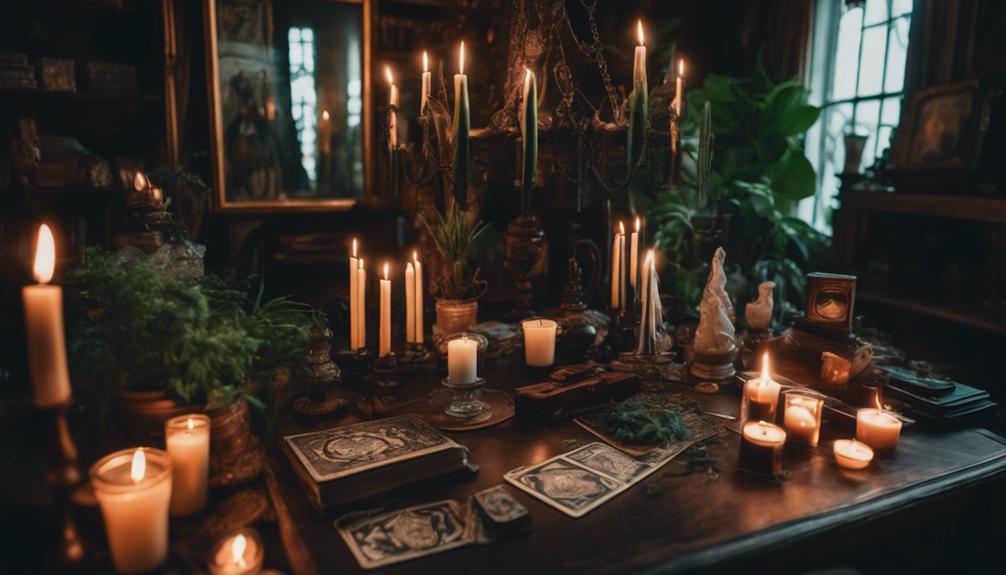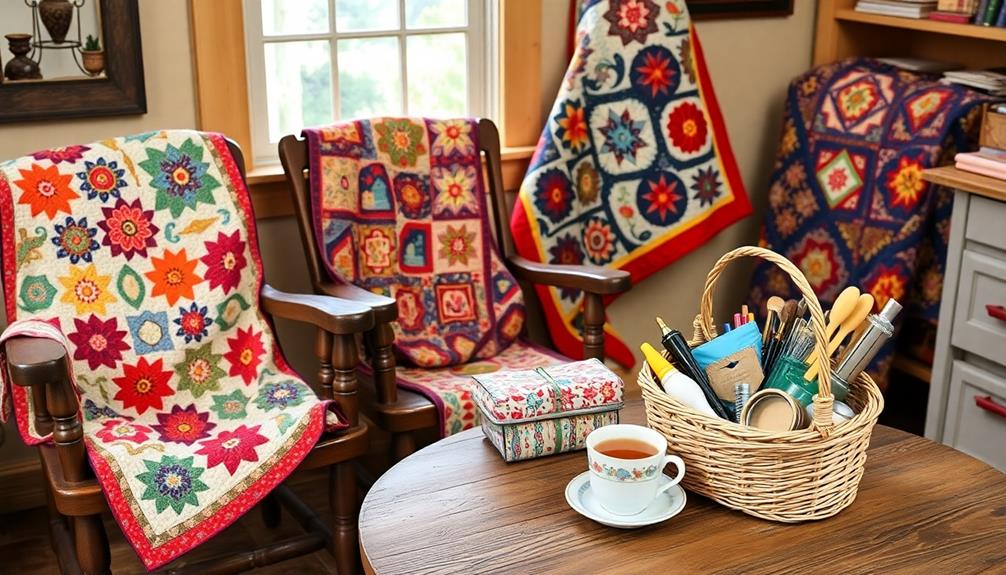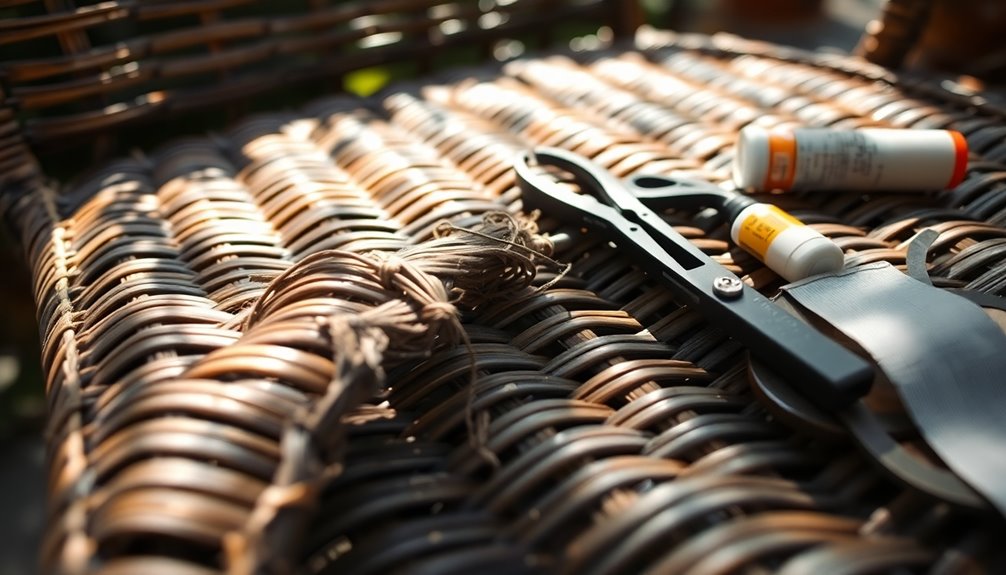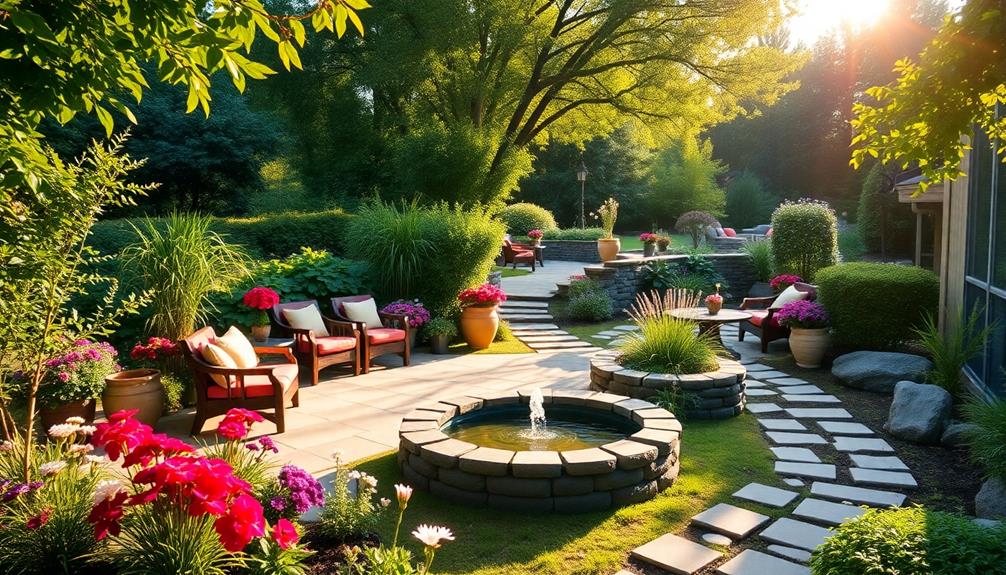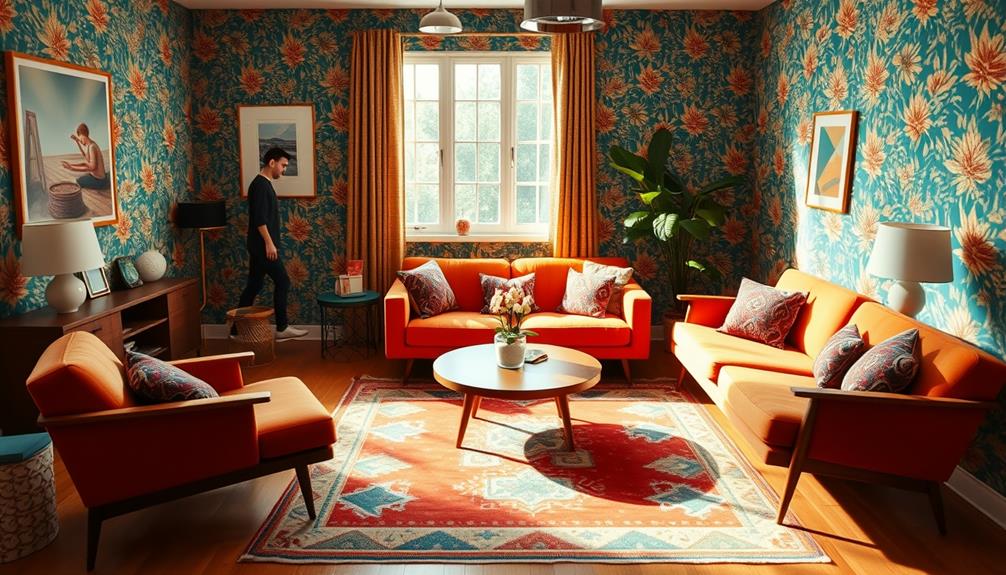To achieve a captivating ambiance, blend witchcore and aesthetic decor featuring deep purples, greens, and earthy tones. Utilize natural materials like dark wood and stone for furniture, and add layers of luxurious textures such as velvet and lace to enhance both comfort and mystique. Incorporate essential elements like antique bookshelves and candlelit lanterns for ambiance, while decorative accents like moon phase hangings and vintage tarot displays bring character. Don’t overlook unique lighting fixtures such as hanging crystal chandeliers and fairy lights to establish the perfect mood. Embrace these design elements, and you’ll discover even more enchanting ideas to elevate your mystical sanctuary.
Key Elements
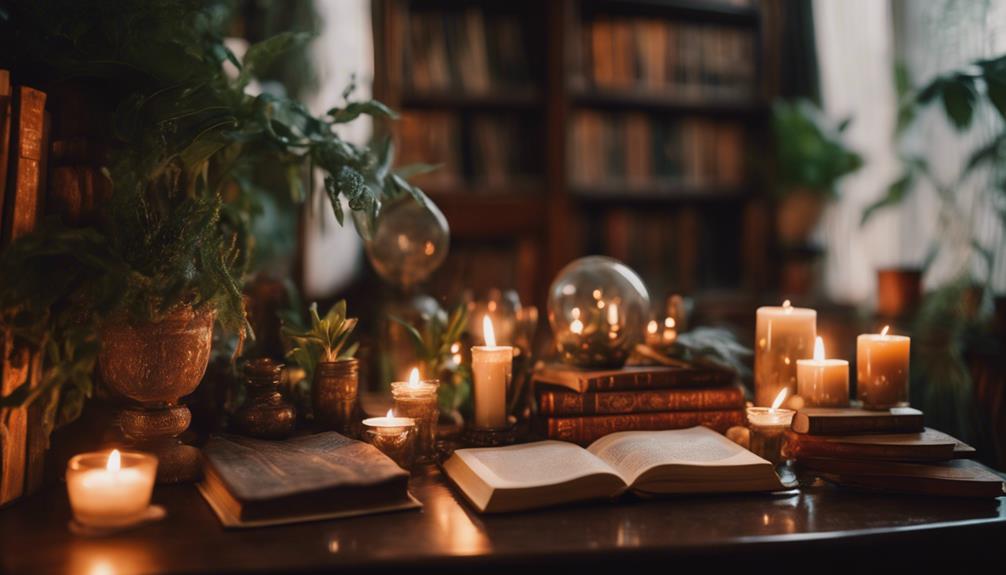
When creating your witchcore room, the color scheme, materials, and textures play an essential role in setting the mood.
You'll want to incorporate dark hues and natural elements to cultivate that enchanting atmosphere.
Let's explore how these key elements can transform your space into a mystical haven.
Color Scheme
How can you create an enchanting atmosphere with a Witchcore color palette that features deep purples, blacks, and forest greens?
Start by embracing these moody hues to establish a mystical vibe in your space. Incorporate earthy tones like browns and muted yellows to connect your decor with nature, enhancing the organic feel of your room.
Don't shy away from mixing in metallic accents like gold, silver, and bronze. These striking elements contrast beautifully against darker shades, adding a touch of elegance and allure.
For a whimsical touch, consider soft pastels like lavender, mint, and blush. These lighter colors can help balance the overall aesthetic while maintaining the enchanting essence.
You might also explore monochromatic schemes by layering varying shades of a single color. This technique creates depth and cohesion, making your Witchcore aesthetic even more intriguing.
Materials
To create a truly enchanting Witchcore space, incorporate natural materials like dark wood, stone, and clay that ground your decor in rustic charm.
Think of sturdy wooden furniture that brings a sense of warmth and connection to nature. Add stone accents, perhaps a small stone altar, to enhance the earthy vibe. Clay pottery can serve as both functional and decorative pieces, housing your favorite herbs or crystals.
Don't forget to introduce potted plants throughout the room. They not only purify the air but also add life and color to your mystical haven. Choose plants that resonate with the aesthetic, like snake plants or pothos, to keep the space feeling fresh and vibrant.
For lighting, opt for warm fairy lights that twinkle softly, creating a magical ambiance without overpowering the room. String them along shelves or drape them over your bed to evoke a cozy, inviting atmosphere.
Combine these materials and elements, and you'll effortlessly weave together a space that invites both comfort and enchantment, leaving anyone who enters spellbound by your perfectly curated Witchcore decor.
Textures
Textures enrich your Witchcore space, blending rich fabrics like velvet and silk with natural elements to create a layered, opulent atmosphere that feels both inviting and mystical. By incorporating materials such as wood and stone, you introduce an earthy quality that complements the witchcore aesthetic, deepening your connection to nature.
Think about adding rustic accents with burlap, which can contrast beautifully against delicate lace or tulle. This mix adds depth and visual interest to your home decor. Textured textiles like embroidered throws or woven wall hangings not only enhance the cozy ambiance but also serve as artistic focal points that draw the eye.
Don't shy away from mixing various textures. Pair smooth glass potion bottles with rough-hewn wooden shelves to create a dynamic environment that captivates the senses. Each texture contributes to the overall enchanting vibe, making your Witchcore space feel like a magical retreat.
Embrace the art of layering textures and let your creativity flow as you curate a home that resonates with the mystical energy of witchcore style.
Essential Fixtures and Furniture
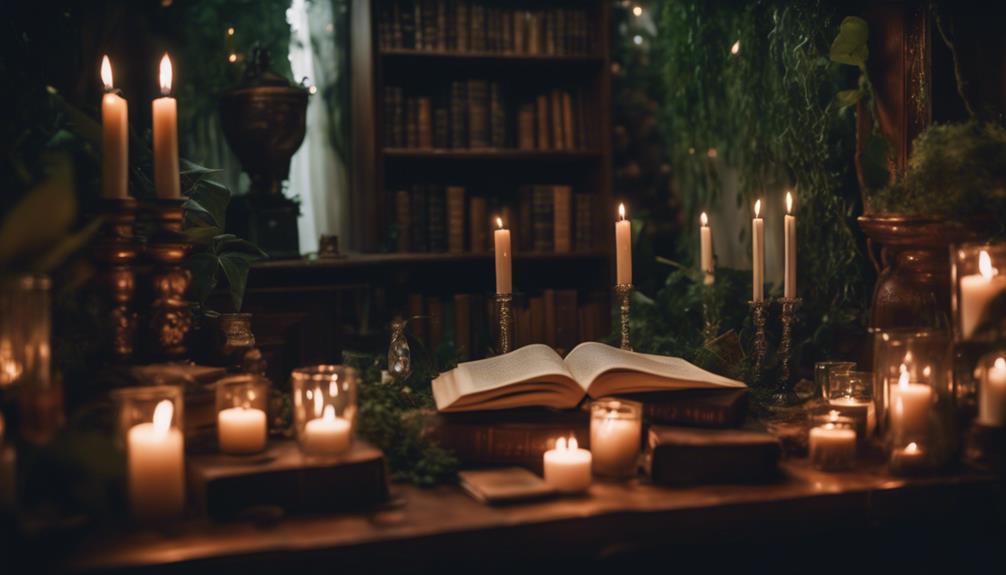
When it comes to essential fixtures and furniture for your witchcore room, you'll want pieces that reflect both style and purpose.
Think about incorporating an antique wooden bookshelf to display your favorite tomes, a vintage cauldron side table for a unique touch, and a crystal ball coffee table to spark a sense of magic.
Each of these items won't only enhance the aesthetic but also serve functional roles in your enchanting space.
Antique Wooden Bookshelf
An antique wooden bookshelf becomes an enchanting centerpiece in your witchcore room, effortlessly combining rustic charm with practicality for displaying your favorite grimoires and mystical decor. This essential fixture not only serves as a focal point but also enhances the moody atmosphere characteristic of witchcore aesthetics. The rich, dark wood tones create a backdrop that adds depth and warmth to your space.
When you incorporate a vintage or distressed bookshelf, you evoke a sense of history and mystique, both crucial for perfect witchcore room decor. It's the ideal place to layer decorative elements like crystals, dried herbs, and unique artifacts, enriching your room's aesthetic experience.
Plus, the versatility of antique wooden bookshelves allows for artistic expression. You can style them with various lighting solutions, such as candles or fairy lights, to create an inviting ambiance that draws the eye. This enchanting piece not only holds your cherished books but also tells a story, making it a significant component of your witchcore sanctuary.
Embrace the charm and practicality of an antique wooden bookshelf, and let it transform your space into a magical retreat.
Vintage Cauldron Side Table
Building on the enchanting atmosphere created by an antique wooden bookshelf, a vintage cauldron side table adds a distinctive touch to your witchcore room, serving both as a practical surface and a mesmerizing focal point. Often crafted from cast iron or brass, these tables evoke a magical ambiance that sparks conversation. You can easily source them from antique shops, thrift stores, or online marketplaces, allowing you to discover that perfect piece with rustic charm.
The unique cauldron design offers creative uses, such as storing potions, crystals, or herbs, while also providing a sturdy surface for displaying candles and decorative items. Incorporating a cauldron side table with darker wood or wrought iron accents enhances your room's witchcore aesthetic, harmonizing beautifully with deep greens, blacks, and purples.
To elevate the enchanting vibe even further, consider pairing your cauldron side table with layered textiles like velvet or lace runners. This combination adds softness and texture, making your space feel inviting and mystical.
Ultimately, the vintage cauldron side table not only fulfills functional needs but also serves as an evocative centerpiece in your magical sanctuary.
Crystal Ball Coffee Table
A crystal ball coffee table instantly transforms your witchcore room into a mesmerizing space, blending functionality with an enchanting aesthetic. This striking fixture serves as a focal point, featuring a glass top supported by a decorative crystal ball base. You can choose a design made from dark wood or wrought iron to complement the moody color palette typical of witchcore decor.
To enhance the mystical atmosphere, look for tables with intricate designs or occult symbols on the base. These elements not only add visual interest but also act as conversation starters for your guests. To elevate the enchanting vibe, accessorize your coffee table with candles, tarot cards, or crystals, creating an inviting area perfect for rituals or gatherings.
Additionally, a crystal ball coffee table symbolizes divination and intuition, reinforcing the spiritual themes present in witchcore aesthetics. This unique design element doesn't just serve a practical purpose; it also deepens the connection to the mystical world, making your space all the more enthralling.
Lighting Ideas
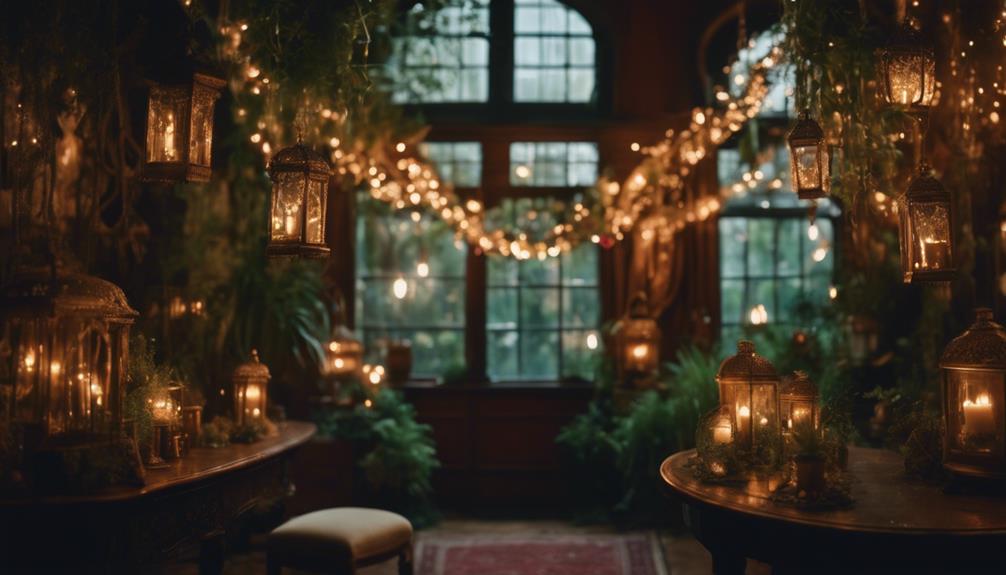
When it comes to witchcore lighting, you can transform your space with a hanging crystal chandelier that sparkles like starlight.
Add candlelit lanterns for a cozy ambiance and moonlit string fairy lights to create a magical vibe.
Don't forget about illuminated crystal orb sconces to enhance the enchanting atmosphere in your room.
Hanging Crystal Chandelier
Hanging crystal chandeliers instantly transform your witchcore room into a magical haven, casting enchanting reflections that enhance the mystical vibe. These stunning fixtures serve as a striking focal point, drawing the eye and creating a mesmerizing atmosphere.
When choosing a chandelier, look for intricate designs that feature a combination of crystals and dark metal finishes. This selection resonates beautifully with the moody color palette typical of witchcore aesthetics.
To elevate the ambiance further, consider chandeliers with multiple tiers. They add depth and complexity to your space, harmonizing with the rich textures present in your decor. The warm glow from the chandelier's bulbs can be complemented by dimmable lighting options, letting you adjust the brightness to suit your mood or activity perfectly.
Moreover, incorporating a chandelier adorned with crystals amplifies the energy in your room, as crystals are thought to promote healing and positivity. With the right chandelier, you'll not only illuminate your space but also create an enchanting sanctuary that invites inspiration and magic into your life.
Embrace the charm of a hanging crystal chandelier, and let your witchcore room shine!
Candlelit Lanterns for Ambiance
Building on the enchanting atmosphere created by hanging crystal chandeliers, candlelit lanterns add a warm, flickering glow that further enhances the mystical vibe of your witchcore room.
These lanterns not only illuminate your space but also create a cozy and inviting ambiance. To truly embody the witchcore aesthetic, opt for lanterns made of wrought iron or aged brass; their rustic charm complements the dark, magical elements of your decor perfectly.
Choose lanterns with glass panels to allow the light to diffuse softly, reducing harshness and contributing to a calming environment. You can elevate the experience even further by incorporating scented candles within these lanterns. Aromas like sandalwood, patchouli, or lavender will envelop your space, enhancing the magical atmosphere.
Grouping multiple lanterns of varying heights creates visual interest and a layered lighting effect, making your room feel even more enchanting. Position them on shelves, tables, or even the floor to cast dancing shadows that evoke a sense of wonder.
With the right candlelit lanterns, your witchcore room will transform into a spellbinding sanctuary that invites relaxation and inspiration.
Moonlit String Fairy Lights
Creating an enchanting atmosphere in your witchcore room is effortless with moonlit string fairy lights that cast a soft, magical glow reminiscent of the moon's light. These lights enhance the mystical ambiance, making your space feel like a starlit night. Available in various styles, you can choose warm white or colored bulbs to perfectly match your room's color palette and decor theme.
Drape them over furniture, walls, or weave them into nature-inspired decor to create a whimsical, dreamlike environment. The gentle illumination invites a sense of tranquility and wonder, ideal for any witchcore aesthetic. Many options are energy-efficient LED lights, providing a sustainable, long-lasting lighting solution that adds charm without a hefty electricity bill.
You can also incorporate moonlit string fairy lights into DIY projects. Illuminate potion shelves or accentuate floral displays to enhance the overall vibe of your room. The possibilities are endless, and with a little creativity, you can transform any ordinary corner into a magical retreat.
Illuminated Crystal Orb Sconces
How can illuminated crystal orb sconces transform your witchcore room into an enchanting haven? These stunning lighting fixtures provide a soft, warm glow that enhances the mystical ambiance you crave. With intricate metal designs, they allow light to filter through, casting mesmerizing shadows on your walls—perfect for creating that witchy vibe.
You'll appreciate the versatility these sconces offer, as many come with adjustable brightness settings. Whether you need a gentle nightlight for quiet reflection or a vibrant glow for rituals and gatherings, you can easily set the mood. For an added touch of magic, consider incorporating colored bulbs in deep purples or greens. These hues complement the dark, moody palette often found in witchcore decor.
Positioning your sconces strategically near mirrors or other reflective surfaces can amplify light and create a fascinating visual display. This not only adds depth to your mystical space but also enhances the overall enchanting feel of your room.
Decorative Elements
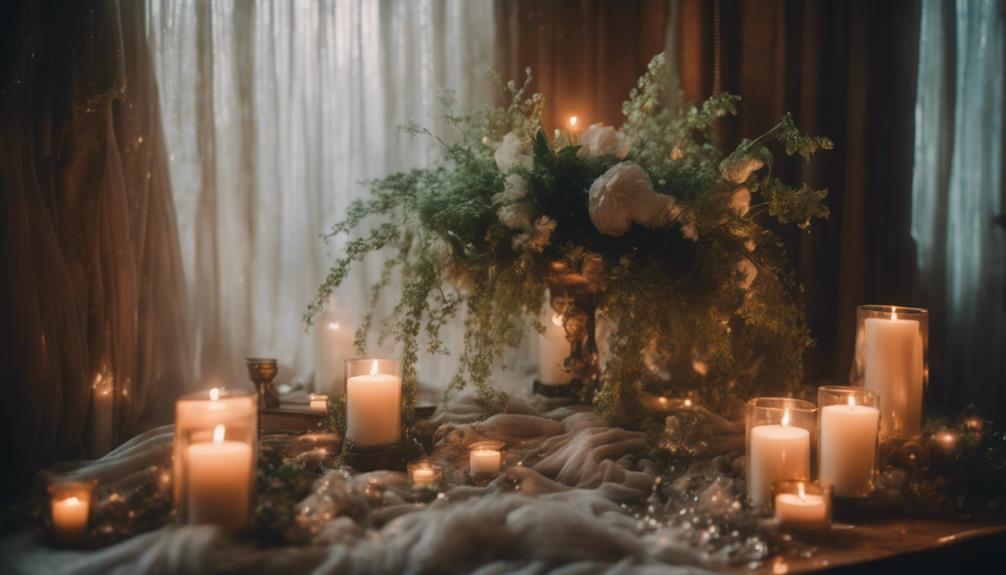
To elevate your witchcore aesthetic, consider adding a moon phase wall hanging that captures the celestial essence of your decor.
An herb-infused dreamcatcher not only adds a mystical touch but also promotes positive energy in your space.
Moon Phase Wall Hanging
A moon phase wall hanging, with its enchanting designs, acts as a mesmerizing centerpiece in any witchcore room, embodying the mystical essence of lunar cycles. These stunning pieces often showcase the different phases of the moon—new, waxing, full, and waning—each symbolizing unique aspects of intention, manifestation, and release in your spellwork.
You can choose materials that resonate with your aesthetic, whether it's wood, metal, fabric, or ceramic, allowing for a personalized touch that enhances your space's vibe. By hanging it at eye level, you promote a deeper connection to lunar energies, making it a powerful tool for meditation, rituals, and setting intentions aligned with the moon's cycles.
To amplify its visual appeal and deepen your connection to nature, consider pairing your moon phase wall hanging with elements like crystals or dried flowers. These additions not only enhance the beauty of your decor but also celebrate the traditions of witchcraft.
As you embrace this celestial charm, you'll create an atmosphere that's both mystical and inviting, leaving you and your guests spellbound.
Herb-Infused Dreamcatcher Wall Hanging
Herb-infused dreamcatcher wall hangings blend traditional craftsmanship with the calming properties of natural herbs, creating a stunning focal point for your witchcore decor. These unique pieces combine the classic dreamcatcher design with dried herbs like lavender, sage, and chamomile, known for promoting relaxation and warding off negative energy.
To craft your dreamcatcher, gather a circular frame, some sturdy string, and your chosen herbs. Weave the herbs into the webbing to enhance both aesthetics and functionality. For added protection, consider incorporating crystals like amethyst or clear quartz, turning your creation into a spiritual tool as well as a beautiful decoration.
Choose a color palette that resonates with the witchcore aesthetic—deep greens and purples work beautifully—while using natural twine or leather for a rustic touch.
Once completed, hang your herb-infused dreamcatcher in a well-lit area. Sunlight filtering through won't only create enchanting shadows but will also allow the herbs to release their calming scents, enhancing the atmosphere of your mystical space. This combination of beauty and intention makes it a magical addition to your decor.
Vintage Tarot Card Display
Crafting a vintage tarot card display not only adds a mystical touch to your decor but also invites conversation and exploration of their rich symbolism.
To create this enchanting focal point, consider using shadow boxes or ornate frames that protect the cards while transforming them into fascinating wall art. The intricate illustrations and deep meanings behind each card can spark curiosity and provide inspiration for your guests.
Choose antique or uniquely styled frames to elevate the elegance of your display, ensuring it aligns with your overall witchcore aesthetic. You can arrange the tarot cards in a fan or stacked formation to add dynamic energy to the space. This setup encourages viewers to investigate the meanings and stories behind the cards.
To further enhance the ethereal vibe, combine your vintage tarot cards with natural elements like crystals or dried herbs. This integration not only amplifies the mystical ambiance but also ties the display into the broader witchcore theme.
Flooring
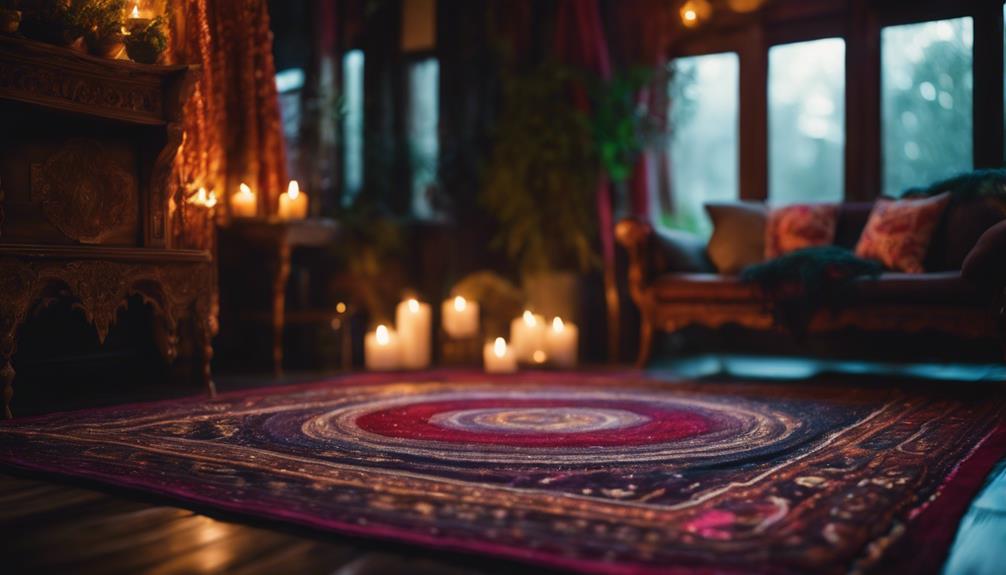
When choosing flooring for your witchcore space, dark stained hardwood adds a rich, moody foundation.
Pair it with a soft, plush velvet rug to create a cozy vibe that invites relaxation.
Alternatively, weathered stone tile can bring an earthy, mystical touch that perfectly complements your decor.
Dark Stained Hardwood Floor
Dark stained hardwood floors set a rich, moody foundation that perfectly complements the Witchcore aesthetic. When you choose darker wood tones like walnut or ebony, you create a striking contrast against lighter decor elements. This balance not only enhances the visual appeal but also deepens the mystical ambiance of your space.
Hardwood is durable and easy to maintain, making it a practical choice for showcasing rustic furniture and various decorative accents that embody the Witchcore vibe. Plus, dark stained floors absorb light, contributing to a cozy and intimate atmosphere—ideal for an enchanting environment filled with candles and soft lighting.
As you explore your decor options, consider how area rugs with intricate patterns can further enhance the magical feel of your room. They add warmth and texture while complementing your dark stained hardwood floors.
This combination creates an inviting atmosphere, perfect for curling up with a spellbook or hosting a witchy gathering.
Soft, Plush Velvet Rug
A soft, plush velvet rug adds a luxurious layer to your witchcore decor, enhancing both comfort and the enchanting atmosphere of your space. The deep, rich colors of these rugs, like dark purples or emerald greens, beautifully complement the moody palettes typical of witchcore aesthetics. As you step onto the velvety surface, you'll feel the plush comfort underfoot, creating a cozy environment perfect for relaxation.
In addition to comfort, the layered texture of a velvet rug contributes to the richness of your room, inviting you and your guests to sink into its warmth. The reflective quality of the fabric catches light from candles and fairy lights, producing a shimmering effect that elevates the overall ambiance.
To truly embrace the witchcore theme, consider choosing a rug adorned with intricate patterns or mystical motifs. This not only serves as a functional element but also transforms it into a statement piece within your decor.
Weathered Stone Tile Flooring
How does weathered stone tile flooring enhance the rustic charm of your witchcore decor? This type of flooring introduces an organic, earthy element that perfectly complements the mystical atmosphere of your space. The natural textures of the stone create a warm, inviting feel, echoing the deep greens and blacks often found in witchcore aesthetics.
Weathered stone tiles aren't only visually appealing but also practical. They're durable and easy to maintain, making them ideal for a stylish yet functional setting. Imagine stepping onto cool, uneven tiles that evoke the essence of an ancient, enchanted environment—it's like walking through a magical domain.
Pair your flooring with warm lighting and natural elements like potted plants or candles to enhance the eerie ambiance. The juxtaposition of the stone's rugged surface against soft furnishings creates an enchanting contrast, inviting curiosity and wonder.
How Can I Combine Witch Room Ideas with Aesthetic Decor for a Mystical and Captivating Space?
Transform your space with mystical charm by combining witch room ideas with aesthetic decor. Use rich, dark colors like deep purples and blacks, incorporate crystal ball accents, and add velvet cushions. Hang ornate tapestries, place vintage candles, and add pops of metallic accents for a captivating and mystical ambience.
Conclusion
By blending aesthetic and witchcore decor, you can transform your space into a mystical haven that resonates with your unique style.
Incorporate key elements like essential fixtures, enchanting lighting, and decorative touches that spark joy and curiosity.
Don't forget to pay attention to your flooring—it sets the foundation for your magical retreat.
Embrace your creativity and let your space reflect your inner sorceress.
With a little imagination, you'll create a room that truly leaves everyone spellbound!
